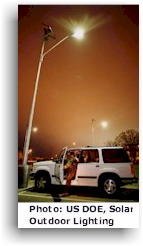

Outdoor lighting is an important safety feature for the workplace. Well-lit properties are less likely to be burglarized. They are also unlikely to be the scene of accidents caused by dark pathways, where people might easily trip and fall. Compact fluorescent lights are the perfect choice for outdoor lighting. Not only can they save you money, they are also energy efficient. Compact fluorescents have to be changed infrequently, which makes them a good choice for places where changing a bulb might be difficult. One note of caution—if you live in a cold climate, be sure to buy a compact fluorescent lamp with a cold-weather ballast. Devices such as timers or photocells can be used to turn lights on and off at appropriate times.
 |
To save energy and money, don't burn lights all night long, except in
areas with actual all-night use or with extreme security concerns. For most security
purposes, motion-sensors can detect intruders and turn on lights when needed. Special
outdoor lighting fixtures can help to beautify your business. Illuminate pathways
with small ground level moon lamps, or light your front steps or entry way with post
lanterns. When planning outdoor lighting, make sure whatever you
choose doesn't light up your neighbor's property as well as your own. Be considerate and
ensure that your lights stay on your property. Good low-glare options are linear
"tube lights" and fiber-optics. These lights can light the way for pedestrians
without illuminating an entire area. Cut-off fixtures, shades, or highly focused
low-voltage lamps are also useful in avoiding spillover. Just as fluorescent lighting has improved in recent years, great advances have been made in high-intensity discharge (HID) ighting. Primarily used outdoors and for large areas like streets or parking lots, there are three kinds of HID lights: mercury vapor, high-pressure sodium, and metal halide. All require ballasts, much like fluorescent lighting. All take several minutes to warm up, so they are better suited to areas in which lights stay on for long periods of time. Mercury vapor lights have been the most common type of HID, but they are quickly being replaced by the newer, more efficient high-pressure sodium and metal halide lamps. High-pressure sodium lights produce the most light—the most lumens—per watt, although the light has a yellowish tinge. Metal halide lights are less efficient but produce a whiter, more natural light. |
You can also use solar energy to power outdoor lighting. During daylight hours, a photovoltaic (PV) panel generates electricity that is stored in a battery in most of the low-power light fixtures. These lights can be turned on manually, they can be equipped with light-sensing controls that turn them on automatically at dusk, or they can be activated by motion-detectors. Most of the lower-priced models on the market do not produce a great deal of light—they're definitely not reading lamps—but they are very useful to light paths and steps around the yard. Using PV-powered outdoor lights is an attractive alternative if your site is over 200 yards from the utility grid, or if you don't want to run a power line through a site. PV power is low-maintenance and very reliable, and installation is often as easy as pushing a stake on which the fixture is mounted into the ground. Larger, brighter PV lights are also available, but these may require additional light panels. Often these additional panels can blend attractively with your buildings's architecture.
|
|

|
| Copyright Aclara Technologies LLC. All Rights Reserved. | |